My code has two ListBoxes (LeftListBox and RightListBox) and one TextBox. Those ListBoxes transfer the items between the them. The TextBox shows a number, which corresponds to the SelectedItem in RightListBox (e.g., when T1 is selected, it shows 10, when T2 is selected, it shows 20, and so on).
I've just made it!! ... but those ListBoxes show only the 1st Dictionary item out of three ... How can I show all of them?
Here is my code:
MainWindow.xaml
<Window x:Class="ListBoxMoveAll.MainWindow"
xmlns="http://schemas.microsoft.com/winfx/2006/xaml/presentation"
xmlns:x="http://schemas.microsoft.com/winfx/2006/xaml"
xmlns:d="http://schemas.microsoft.com/expression/blend/2008"
xmlns:mc="http://schemas.openxmlformats.org/markup-compatibility/2006"
xmlns:local="clr-namespace:ListBoxMoveAll"
mc:Ignorable="d"
Title="MainWindow" Height="450" Width="600">
<Grid>
<Grid.ColumnDefinitions>
<ColumnDefinition Width="2*" />
<ColumnDefinition Width="80" />
<ColumnDefinition Width="2*" />
<ColumnDefinition Width="*" />
<ColumnDefinition Width="2*" />
</Grid.ColumnDefinitions>
<Grid.RowDefinitions>
<RowDefinition Height="*"/>
<RowDefinition Height="*"/>
<RowDefinition Height="*"/>
</Grid.RowDefinitions>
<ListBox x:Name="LeftListBox" Grid.Row="0" Grid.RowSpan="3" Grid.Column="0"
ItemsSource="{Binding LeftListBoxItems}" DisplayMemberPath="Key" SelectedValuePath="Value"
SelectionMode="Extended" Margin="0,10"/>
<StackPanel Grid.Column="1" Grid.Row="0" VerticalAlignment="Center">
<Button Content="Add" x:Name="Add_Button" Click="Add_Button_Click"/>
</StackPanel>
<StackPanel Grid.Column="1" Grid.Row="2" VerticalAlignment="Center">
<Button Content="Remove" x:Name="Remove_Button" Click="Remove_Button_Click"/>
</StackPanel>
<ListBox x:Name="RightListBox" Grid.Row="0" Grid.RowSpan="3" Grid.Column="2"
ItemsSource="{Binding RightListBoxItems}" DisplayMemberPath="Key" SelectedValuePath="Value"
SelectionMode="Extended" Margin="0,10"/>
<StackPanel Grid.Column="4" Grid.Row="1" Grid.RowSpan="1" Margin="0,10">
<TextBox Text="{Binding SelectedValue.Step, ElementName=RightListBox}"/>
</StackPanel>
</Grid>
</Window>
MainWindow.xaml.cs
using ListBoxMoveAll.Model;
using System.Collections.Generic;
using System.Collections.ObjectModel;
using System.Linq;
using System.Windows;
namespace ListBoxMoveAll
{
public partial class MainWindow : Window
{
public ObservableCollection<Dictionary<string, Graph>> LeftListBoxItems { get; }
= new ObservableCollection<Dictionary<string, Graph>>();
public ObservableCollection<Dictionary<string, Graph>> RightListBoxItems { get; }
= new ObservableCollection<Dictionary<string, Graph>>();
public MainWindow()
{
InitializeComponent();
DataContext = this;
Dictionary<string, Graph> Dic = new Dictionary<string, Graph>();
Dic.Add("T1", new Graph(10));
Dic.Add("T2", new Graph(20));
Dic.Add("T3", new Graph(30));
LeftListBoxItems.Add(Dic);
// Yes! There are three items in Dic!
foreach (var item in Dic)
{
MessageBox.Show(item.ToString());
}
}
private void Add_Button_Click(object sender, RoutedEventArgs e)
{
//foreach (TestModel item in LeftListBox.SelectedItems.OfType<TestModel>().ToList())
foreach (Dictionary<string, Graph> item
in LeftListBox.SelectedItems.OfType<Dictionary<string, Graph>>().ToList())
{
LeftListBoxItems.Remove(item);
RightListBoxItems.Add(item);
}
}
private void Remove_Button_Click(object sender, RoutedEventArgs e)
{
foreach (Dictionary<string, Graph> item
in RightListBox.SelectedItems.OfType<Dictionary<string, Graph>>().ToList())
{
RightListBoxItems.Remove(item);
LeftListBoxItems.Add(item);
}
}
}
}
Model/Graph.cs
namespace ListBoxMoveAll.Model
{
public class Graph
{
public Graph(int step) { Step = step; }
public int Step { get; set; }
}
}
Since the foreach statement shows that there are three items in Dic, I think my XAML has an issue, but I cannot figure that out. You guys might know what the issue is. Sorry if this is a very basic question ... Thank you in advance.
New Discovery: I've added another foreach statement for LeftListBoxItems:
foreach (var item in LeftListBoxItems)
{
MessageBox.Show(item.ToString());
}
... The output is only once and the content is:
System.Collections.Generic.Dictionary`2[System.String,ListBoxMoveAll.Model.Graph]
What does this mean?
